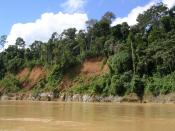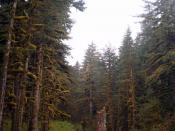One of the planet's most powerful and bio-actively diverse natural phenomenon are known to be the rain forests. To start off, it is important to be knowledgeable about what a rain forest really is. For that, one has to understand the importance of the rain forests itself. Although they are characterized by tall trees, abundant rainfall, and warm temperature year-round there are two types of rain forests: tropical and temperate.
Temperate rain forests are much more scarce than tropical rain forests. As the name suggests, tropical rain forests, are defined by their dry and wet seasons. In fact, these forests receive 400 to 1000 cm of rain each year. A tropical rain forest grows in four layers: the emergent trees, canopy, the understory, and the forest floor. The very top layer consists of the emergent and canopy, which is composed of the tallest trees and is approximately 60 to 65 feet above the ground.
As a result, photosynthesis cease to exists in the rain forest because only one to two percent of the light at the top of the canopy is able to reach the floor below. Since the canopy is where most of the plants growth occurs in the sun, so many tropical birds, snakes, frogs, apes, monkeys, and other animal reside in the canopy as well. Just below the canopy is another layer called the understory. It is here that many small trees and shrubs are found along with the little homes resided by small animals such as anteaters, lemurs, and tree kangaroos. The plants in this layer are relatively small because the canopy blocks most of the sunlight from reaching to them. Similarly, in the forest floor, the soils are very poor causing it to be almost bare because of trees not allowing for ample...


